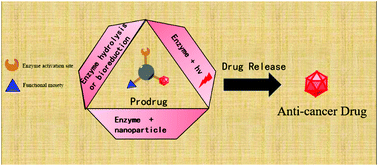Enzyme-activated prodrugs and their release mechanisms for the treatment of cancer
Abstract
Enzyme-activated prodrugs have received a lot of attention in recent years. These prodrugs have low toxicity to cells before they are activated; when they interact with specific enzymes, they can effectively release anticancer drugs, thereby achieving the effect of treating cancer. At the same time, compared with other thiol-activated prodrugs, reactive oxygen species-activated prodrugs, and acid-activated prodrugs, the specificity of enzyme-activated prodrugs is stronger; therefore, these prodrugs have greater development potential. In this review, we summarize the different release mechanisms of prodrugs on the basis of enzyme-activated prodrugs, such as enzyme reduction, enzymatic hydrolysis, enzyme-activated and light-radiation-assisted release, and enzymatic-activated and nanoparticle-assisted release mechanisms. A profound understanding of these release mechanisms will contribute to the design of enzyme-activated prodrugs.

- This article is part of the themed collection: Journal of Materials Chemistry B Recent Review Articles


 Please wait while we load your content...
Please wait while we load your content...